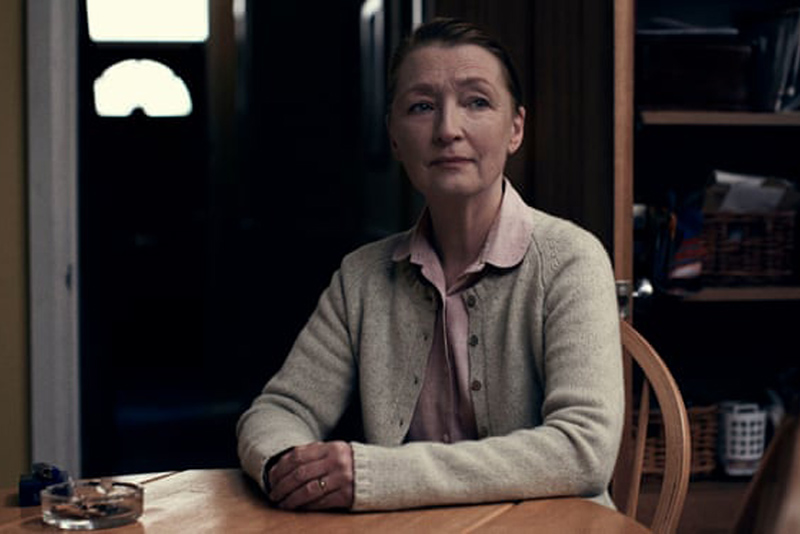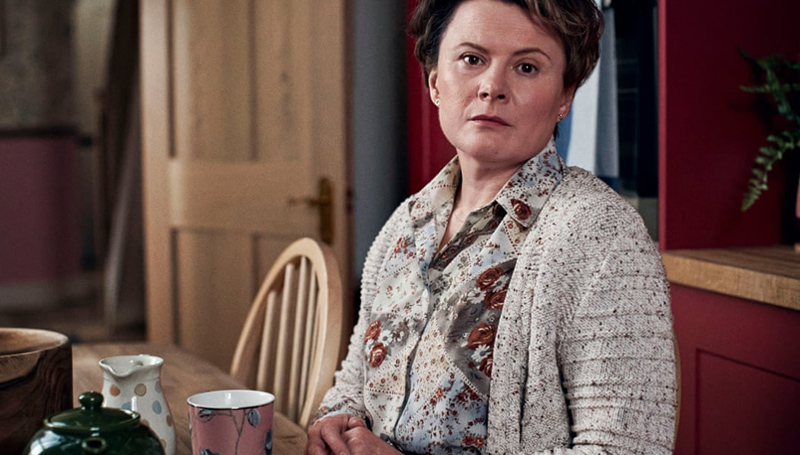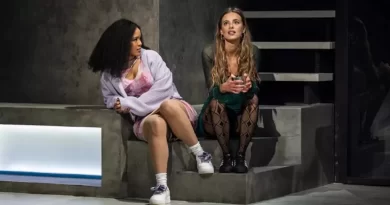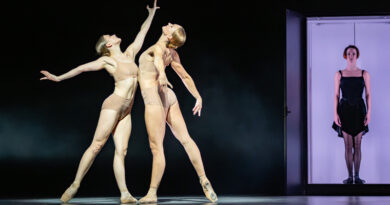“Bed Among the Lentils” and “The Shrine”: Alan Bennett
Jeremy Malies on the South Bank
1 September 2020
As with the other pair of plays I review from the same series, the direction of Bed Among the Lentils by Nicholas Hytner is unobtrusive though you sense that he has helped the performer explore character from within. Lesley Manville is perfectly cast and inhabits her role from the off as Susan, the unfulfilled alcoholic wife of a quite ghastly Anglican vicar in a country parish outside Leeds. This is Bennett on top form exploiting a medium that to a large extent he created himself, the monologue in which a character switches between talking to us, the audience, and talking to their inner wiser self who would have made better decisions in life.
Raised in the Church of England, Bennett has become an agnostic but is clearly fascinated by church architecture and the liturgy. He has also, on this showing, seen much posturing by the clergy and nobody has skewered them like this since Trollope. Anybody will realize immediately that Susan is consuming industrial quantities of sherry. When the communion wine goes missing and parishioners have to take the sacrament with Benylin (a mildly alcoholic cough syrup kept by the verger in case any of the choir boys are ‘chesty’) things are obviously awry. This is a frayed middle-class couple and, on account of owing money to the nearby off-license, Susan begins making trips (no doubt over the limit) to a late-night grocery in Leeds. Here she gets a lot more than a bottle of Tío Pepe dry.

Lesley Manville in Bed Among the Lentils.
Susan has already spoken of “rare and desiccated conjugations” with her husband. By contrast, Mr Ramesh, the Hindu grocer, is glamorous, mysterious and exudes an intoxicating musk. They flirt a few times and he makes up a bed (among sacks of lentils – hence the odd title of the play) at the back of the shop. This is nothing like the vicarage; here she is not an adjunct and is wanted for herself as part of a meaningful act of union with a lover who is exquisitely considerate and courteous. Manville is particularly empathetic in this section and on the kind of technically assured masterful form that won her an Olivier for the lead role in Ibsen’s Ghosts six years ago. Sadly, it’s the last time I saw her and I regret missing much of her recent work.
The lens may be close-in on Susan at home, but Bennett widens our perspective as he draws contrasts between Hinduism and Anglicanism. In interviews, he takes pride in knowing “Hymns Ancient and Modern” backwards but there are no prizes for guessing where his sympathies are as he has Susan take in some fruity images from the Mahābhārata during foreplay. “I watch him undress and think of them all at evensong … It’s the first time I understand what all the fuss is about.”
Bennett’s scepticism about the clergy (or more specifically Susan’s nightmare husband Geoffrey) becomes acute when Geoffrey begins treating her recovery from alcoholism as a piece of Damascene material for his sermons. This is Susan’s true tragedy; she is a kind of trophy wife in reverse and Geoffrey references her addiction on the slightest pretext. Susan is already teetering on the brink of atheism and we feel this may push her over the edge. But her wit will stay with her. “Why is the vicar’s wife expected to go to church at all? A barrister’s wife isn’t expected to go to court, an actor’s wife doesn’t attend every performance.”
The structure here is simple compared with many of the other monologues. Unless I’ve underestimated her, Susan is a reliable narrator. She also understands herself and her betrayal by Geoffrey who railroads her into his clerical dog and pony show to impress the bishop and gain promotion. This is the most painful aspect of a play that questions faith of all kinds and marriage as an institution.
My final “Talking Heads” monologue, The Shrine, is every bit as cheerless and sepulchral as its name suggests. Interestingly, this is the one new piece in the stage offerings at the Bridge; Bennett wrote it recently having been struck by the profusion (hardly a new trend but increasingly noticeable) of roadside floral tributes to accident victims. Is there a thematic link with the other piece? I’m not sure except there are yet more vicars! Perhaps the author could write an upmarket version of See How They Run and flush this obsession out of his system?
We meet Lorna (played by Monica Dolan) who has just been told that her motorcyclist husband Clifford has died in an unwitnessed crash while riding his bike. Initially, she grieves at home but then she begins to visit the spot where ‘Cliff’ as he is known to the biker community came off. There’s a big revelation from the police via their forensics team; Cliff had come off in every sense and was having an orgasm as he crashed courtesy of a pillion passenger. Lorna meets a woman called Bess who is also leaving flowers. She may have been Cliff’s sexual partner, but we are never sure. Dolan is compelling as she has her character sheds skins of self-respect in quiet desperation while her world crumbles. Her vowels may be flat but her emotions are on a rollercoaster once she escapes an initial numbness.

Monica Dolan in The Shrine.
There are of course many good gags. Lorna is nowhere near as demure as her subdued external manner and dowdy cardigan would suggest. She can be cynical and distrustful of authority figures. Asked if she might like to try counseling, Lorna responds in a flash: “Who does that, the RAC?” She is also onside with Bennett’s campaign against the mangling of the English language and is withering when people use the word “closure”. As with many of these monologues, a whole world is conjured for us such is Bennett’s art and we find ourselves analyzing the dynamics of relationships.
As with Playing Sandwiches from the other pair of monologues I saw, four-time-Olivier-winning designer Bunny Christie produces a symphony of greens for the road and foliage in all weathers. They are projected onto screens in Luke Hall’s video design which bookends major episodes in the narrative. George Fenton (who, incredibly, has been collaborating with Bennett since 1968 with music for the original Forty Years On) reflects Lorna’s isolation and desperate musings with stark chords in his original score. The play puts a new spin on the truism that none of us will ever truly know our spouses who often have secret lives.
This is a sadder play than Bed Among the Lentils, centering as it does on a betrayal that can’t even be thrashed out properly since the betrayer is dead. The image of Lorna using Cliff’s two crash helmets (the second had been hidden in his pannier and proved a surprise) as planter pots for the shrine she creates will haunt me as a study in grief. These two pieces contradict the current contrarian opinion that Bennett loathes his characters. A woman primarily stuck at home, venturing out occasionally and mourning a loved one is a play for our times.
Locked down again as I type this, I feel privileged to have seen four “Talking Heads” plays at this brave unsubsidized venue. It’s as though I committed a smash and grab raid on my trips to central London and came away with valuable spoils. Bennett’s understanding of human nature is remarkably broad, something that may be the first requirement of a playwright. His world is always credible and multi-faceted with depth but it’s a sombre place in which I wouldn’t want to tarry.









